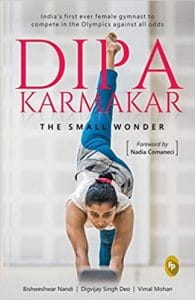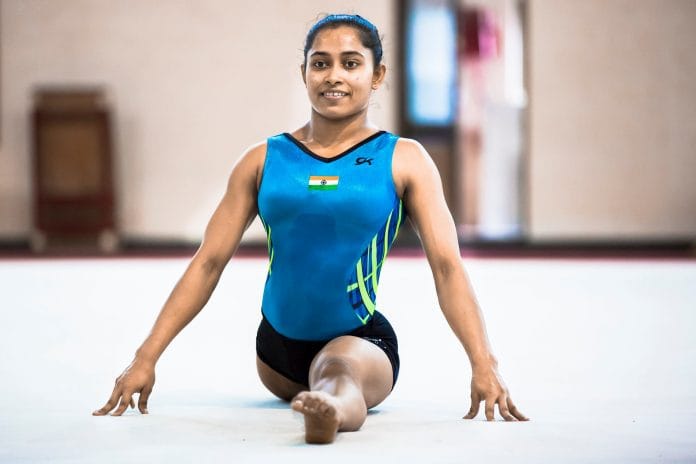In this excerpt from the book Dipa Karmakar: The Small Wonder, the Olympian gymnast describes her journey to the bronze medal at the 2014 Commonweath Games.
Ahead of the CWG 2014, I was in a better frame of mind. My fitness levels were absolutely fine. I had speed. I had power. And most of all, I had the zeal and courage to perform. I felt enthusiastic and the vaulting table looked exciting. Fear never touched me while performing any difficult exercise in gymnastics. Among gymnasts, one’s courage and hard work are the two most important differentiating factors. Besides, I have huge faith in my coach. Faith generates courage. So, I was ready to do any amount of hard work for the most difficult vault in gymnastics history—the Produnova.
This vault is named after a famous gymnast of Russia called Yelena Produnova. She first performed it in 1999. Everyone was pretty shell-shocked when she executed it; the very nature of the vault has led to it being nicknamed the ‘vault of death’. But I never thought of it like that. Even Nandi sir [Dipa’s coach Bishweshwar Nandi] detested this name. I knew of his concern but it never bothered me, even though it had been completed by only a few in the world. That became an additional incentive for me to be a part of an elite league. Yelena Produnova of Russia, Yamilet Pena of Dominican Republic, Fadwa Mahmoud of Egypt, and my hero Oksana Chusovitina of Uzbekistan were the only gymnasts who had completed this difficult but immensely beautiful vault in a competition.
I was practising really hard for the coming CWG. Six to eight hours every day. I used to do eight to ten repetitions every day. We used to spend almost six hours for vaulting exercises and around two hours in conditioning exercises. It was not easy at all. In fact it was quite painful. Sometimes I used to cry a lot and complain to Nandi sir that I was not a machine. Sometimes, he used to allow me to rest. But then I used to cry and say, “I will keep doing it. I want to see how many times you can force me to do it again and again.” We didn’t have smooth times. He forced me to practice hard and I fought a lot. Before going to the Glasgow CWG I had done the Produnova around five or six hundred times and we were quite satisfied. I had attained a level of perfection on the classic Produnova vault.
As we reached Scotland, we wanted to start our practice session as soon as we could. But my start in Scotland proved to be a difficult one. In the qualification round, during the warm-up time itself, my ankle got hurt. But, I performed all the exercises with a hurt ankle, even the Produnova.
Nandi sir was really angry. He left all of us and went to his room. Later I was told that he cried a lot. His complaint was that my attempt for the Produnova itself was wrong. Besides, he was very disheartened. He thought that the Games were over for me before they had even started. He was also scared about what he would tell the authorities and the other members in the team. It had been a struggle for him to gain acceptance within the coaching set-up. He was the outsider and he sort of felt that with this defeat the walls would close on his coaching career in the national team.
Nandi sir is a very emotional man. Since he had locked himself up in his room and wasn’t to be seen at the dining hall or within the Village there was no way for anyone to get in touch with him. I was hobbling around and was advised rest. Finally around one in the night some of my teammates decided that it was time to snap him out of his dark mood. He was staying on the second floor in another wing of the building the Indian team was put up in.
The girls shouted, “Nandi sir, Didi (Dipa) has qualified.” That did it. He did not believe it. He came running to the ground floor to crosscheck whether it was a prank. They told him that I had come seventh in the qualification round and had reached the final. The transformation was immediate.
He came to meet me the next morning and immediately took me to meet the doctor in the Games Village. The doctor saw my swollen ankle and told me that it appeared to be a hairline fracture. He asked us to get an X-ray done and gave me some painkillers meanwhile. I took the painkillers and other medicines but I preferred to wrap my foot tightly with a crepe bandage than get an X-ray done. It was a peculiar situation. Here was I, on the cusp of achieving a dream that had dominated four years of my life and I was not sure whether I could even compete. The crushing defeat in Delhi and the taunts that I had endured had carried me through till this day. I did not want to finish out of the medals and face ridicule again. The anger and the stubbornness kicked in. Goodbye X-ray. To hell with it. I was willing to have my ankle in a cast for the next three months or even six months. You do hear of sportspersons digging deep and finding that little bit extra when they need it the most. This was when I needed to find that extra few per cent which would give me the strength to ignore the pain.
The final was to happen three days later on the 31st of July. I could not practice for another three days. But Nandi sir was still confident that I would do well. We did keep training, just enough to keep the body in shape. Nothing fancy, nothing hard that would cause the ankle more discomfort. I used to say that I would surely get a medal but sir would always ask me to keep mum. He always has been a very superstitious man. I had nothing to lose and I decided to go for it. The team knew I was injured, they just didn’t know the fire raging within to not quit.
As I stood at the top of my mark on the day of the final, I just thought one thing. Keep it simple. Land the vault and ignore the pain. The first vault was going to be the most important one. It was the Tsukahara 360. If I could not land it then it was over as the Produnova would need a much bigger effort and there is only that much an injured ankle can take. I set off, eyes on the beat board and nothing else. There was no stopping me; momentarily the pain had gone and I hit the vault perfectly. The landing was not the best; I was not in control and I fleetingly stepped over the red line and was docked a 0.1 penalty as well. But importantly the ankle held up. As I walked back to the top of my mark I made eye contact with sir and gestured to fix the beat board for the next attempt. I glanced up at the large monitor to catch a replay and was very happy with the aggression I showed. The score soon flashed on the display board. Despite the not-so-great landing, I had scored a 13.633. I was way off the pace as far as the medal hunt was concerned. Later I realised it was the lowest score among all eight finalists on the first attempt.
To win a medal, I needed a big one. I knew I had the Produnova coming up. I felt good. The ankle was not hurting. Everyone else—the coaches, the finalists, and the judges— knew I was going to attempt it. It was a hit or miss moment; if I landed it, it would give me a lot of points. My other competitors had all decided to play safe. The highest difficulty level, attempted apart from me, was a 5.600 by England’s Claudia Fragapane. The Produnova had a difficulty rating of 7.00.
The crowd too knew that this was going to be a difficult vault. As I stood at the top of my mark the whistles and the cheering gradually ceased. There was pin drop silence as I thundered down the mat. I had done this on a daily basis in New Delhi. It was the easiest vault in the world. I knew it was mine. I knew this was in the bag.
I hit the beat board, got the elevation and landed on my feet. The crowd went wild. The emotions came pouring out. Usually I do not react much after a vault. Not that day, though. Within a second of landing I knew that I had just sent shockwaves throughout world gymnastics. A huge smile appeared on my face. I do not know what took over me; it was perhaps the release of the tension and the stress. That ankle be damned. It had done its job and held up.
 Excerpt from Dipa Karmakar: The Small Wonder, by Bishweshwar Nandi, Digvijay Singh Deo and Vimal Mohan (Fingerprint, 2018), pp. 142-144, 153-158.
Excerpt from Dipa Karmakar: The Small Wonder, by Bishweshwar Nandi, Digvijay Singh Deo and Vimal Mohan (Fingerprint, 2018), pp. 142-144, 153-158.






